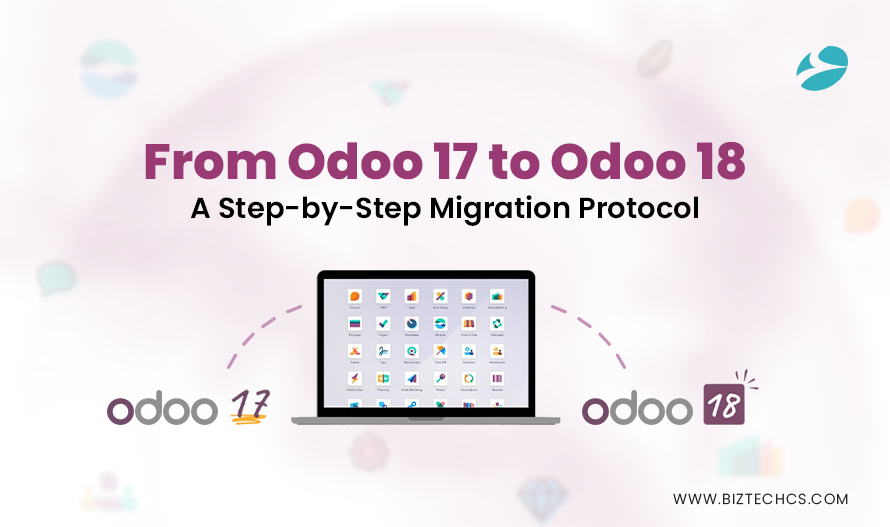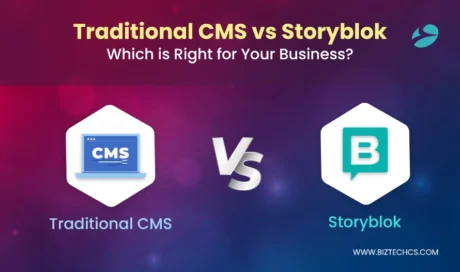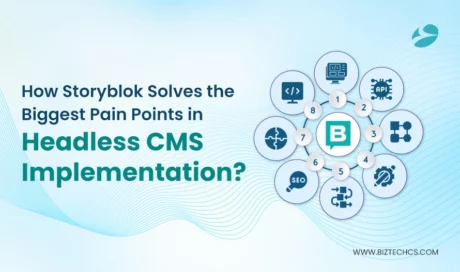1522
From Odoo 17 to Odoo 18: A Step-by-Step Migration Protocol
07 Feb, 2025
10 min read
1522
07 Feb, 2025
10 min read
Table Of Content

Businesses dedicated to staying ahead in their market sector should execute a transition from Odoo 17 to Odoo 18. The current version contains AI integration, improved security standards, and an enhanced user interface.
Sales modules, CRM, and Accounting and HR components have been altered to enhance operational efficiency. The up-to-date functionality of Pos check-out improvements, better invoice management, and enhanced security frameworks offer businesses a compelling upgrade to Odoo 18.
Updates released regularly will give you the most recent bug fixes with added features alongside long-term sustaining capabilities. This guide shows you step by step how to conduct a smooth migration process.
This guide provides a migration path that will help you transition seamlessly into Odoo 18 while accessing its complete capabilities.
Yearly versions from Odoo bring enhanced capabilities to manage business operations better efficiently. Upgrading lets your business benefit from new tools paired with advanced enhancements. Here’s why moving to the latest Odoo version is a decision that benefits your business:
Each Odoo software update presents organizations with new features together with upgraded modules. Additional features in Odoo help organizations handle their operations better and streamline their workflow processes.
The developer team implements 2-3 new supporting or core modules, continually improving user experience and organizational efficiency during operations.
The focus on speed exists as a central feature in each new Odoo product version. The performance boost from Odoo 14 reached 3.5 times faster compared to Odoo 13.
Every new version maintains increased efficiency for front-end and back-end operations until the following release. Upgrading gets you a platform with enhanced performance that expands as your business requirements grow.
System stability and bug fixes, represent the main priority for Odoo development. The product support team provides maintenance to the latest three versions. Following the launch of Odoo 14, only versions 12 through 14 received official updates from the development team.
Upgrades from Odoo version 11 to newer versions are impossible because they do not receive official fixes or bug updates, leading to unresolved problems.
If you’re using an older Odoo version, upgrading is essential to stay competitive. Running outdated software can slow down operations and limit access to the latest business tools.
Before starting with upgrading or Odoo Migration, understand what you’re working with. List all installed modules and check if they are compatible with Odoo 18. If you’ve customized Odoo, evaluate if those changes need adjustments. Review your data to ensure it’s clean and up to date. A thorough assessment helps prevent unexpected issues later.
A well-structured plan keeps the transition smooth. Define your reasons for upgrading and set clear goals. Identify the Odoo 18 key features that will benefit your business. Assign roles to your team, including IT staff, consultants, and developers. Budget for licensing, development, and training costs.
Never upgrade without a full backup of your current system. This acts as a safety net in case something goes wrong. Clean up unnecessary data to avoid clutter in the new version. Standardize formats to prevent compatibility issues. Ensuring data integrity now saves time during migration.
Test before going live to catch issues early. Create a staging environment that mirrors your real system. Check if your modules and workflows function correctly in Odoo 18. Involve key users to provide feedback on performance and usability. Testing reduces the risk of downtime during migration.
A system upgrade is only successful if your team can use it efficiently. Organize training sessions tailored to different departments. Provide user manuals, videos, and hands-on workshops. Communicate the benefits of Odoo 18 to encourage adoption. A well-trained team ensures a smooth transition.
Once testing is successful, deploy Odoo 18 during a low-traffic period. Monitor the system closely for any glitches. Have your IT team ready to resolve unexpected issues. Keep communication open with employees to address concerns. A structured go-live process minimizes business disruptions.
The upgrade doesn’t end at deployment. Track system performance and address any bugs immediately. Continue training employees as they adjust to the new system. Explore new Odoo 18 features to maximize efficiency. Regular improvements ensure long-term success with the upgrade.
Moving data from the old system to the new version is a delicate process. If not done correctly, it can lead to missing records, corrupted files, or inconsistencies. Large databases make this task even more challenging, requiring extra care in mapping and validation. Ensuring smooth migration demands thorough planning and testing.
Custom-built modules or third-party apps may not work as expected after the upgrade. Some features might break, requiring developers to update or rebuild them. Identifying and fixing these compatibility issues takes time and technical effort. Businesses should assess their customizations before upgrading to avoid surprises.
Users may struggle with new interfaces, modified workflows, or unfamiliar features. Without proper training, productivity can drop, and errors may increase. A well-structured training plan ensures a smoother transition. Providing guides, workshops, and support reduces frustration and helps users adapt quickly.
Skipping thorough testing is a major risk that can lead to system failures. Bugs, performance issues, or broken workflows must be identified before going live. Testing should cover different scenarios, including real user interactions. A proper testing phase ensures the upgrade doesn’t disrupt daily operations.
Upgrading Odoo ERP may require system downtime, affecting productivity. If not planned well, even a short outage can impact operations. Scheduling upgrades during off-peak hours helps minimize disruptions. Backup plans should be in place in case rollback is needed.
Addressing these challenges early ensures a smooth transition to the new Odoo version. Proper planning, testing, and training reduce risks and keep business operations running efficiently.
Upgrading to Odoo 18 requires careful planning to avoid disruptions and ensure a seamless transition. Follow these best practices to minimize risks and make the upgrade process smooth and efficient.
Start with a clear roadmap that outlines key objectives, timelines, and responsibilities. Identify critical modules that need attention and define how the new version will support business operations.
Always create a complete backup of your database and files before starting the upgrade. This ensures you have a fallback in case of data corruption or unexpected failures. Don’t just create backups—test them to confirm they work.
Review your custom modules, workflows, and integrations. Identify what needs to be updated or replaced to ensure compatibility with Odoo 18 key features. Keep detailed documentation of these changes for future reference.
Never upgrade directly in production. Set up a staging environment that mirrors your live system. Run the upgrade here first to spot potential issues, test all functionalities, and fix errors before rolling out changes to users.
Engage team leads and end-users early in the process. Their insights will help refine workflows and ensure that the new version meets business needs. Arrange training sessions to help staff adapt to new features.
After going live, closely monitor system performance and user experience. Track speed, error logs, and functionality issues. Be ready to apply quick fixes and optimizations as needed.
Document every step of the upgrade process, including challenges faced and solutions applied. This helps in future upgrades and serves as a reference for training new team members.
Utilize Odoo-certified partners, forums, and official documentation to navigate complex upgrade challenges. If needed, consult experts who specialize in Odoo migrations.
Keep users informed about the upgrade timeline, downtime (if any), and expected changes. Provide support channels to address concerns and assist users in adapting to new workflows.
Once the upgrade is complete, conduct a post-upgrade review. Gather feedback, analyze any shortcomings, and fine-tune processes to get the best out of Odoo 18’s new features.
Upgrading from Odoo 17 to Odoo 18 is a crucial step for businesses looking to enhance efficiency and stay up to date with the latest features. A well-planned migration ensures smooth transitions, minimized downtime, and optimized performance.
By following a structured approach, businesses can make the most of Odoo 18’s improvements without disrupting daily operations.
At BiztechCS, we have the expertise to handle Odoo migrations seamlessly, backed by 18+ years of experience.
Our proven track record and strong customer base as a trusted Odoo Partner highlight our ability to deliver successful migrations. If you’re ready to upgrade, our team is here to support you every step of the way.

Storyblok
23794
By Devik Gondaliya
02 Apr, 2025

Storyblok
24766
By Devik Gondaliya
01 Apr, 2025

Storyblok
25489
By Devik Gondaliya
27 Mar, 2025